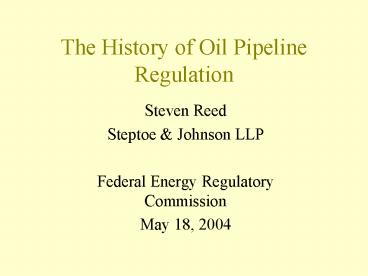The History of Oil Pipeline Regulation PowerPoint PPT Presentation
1 / 20
Title: The History of Oil Pipeline Regulation
1
The History of Oil Pipeline Regulation
- Steven Reed
- Steptoe Johnson LLP
- Federal Energy Regulatory Commission
- May 18, 2004
2
Three Questions
- How did oil pipelines come to be regulated by the
federal government? - How has federal regulation evolved over time?
- What does it mean today?
3
Background of U.S.Oil Pipeline Regulation
- Development of U.S. Oil Industry
- John D. Rockefeller/Standard Oil
- 1906 Pivotal Year
4
Origins of the Oil Industry
- What does Moby Dick have to do with the origins
of the oil industry? - Who was Colonel Edwin Drake?
- Why does a barrel of oil contain 42 U.S. gallons?
- Who was Samuel Van Syckel?
5
Standard Oil
- Founded in 1870 by John D. Rockefeller in
Cleveland, Ohio - Controlled 90 of oil refining and 80 of oil
transportation markets in U.S. - Posted prices
- Rebates and drawbacks
- Squeezed out independents
6
Hepburn Act of 1906
- Brought oil pipelines under Interstate Commerce
Act of 1887 (originally applied only to
railroads) - President Theodore Roosevelt and Senator Henry
Cabot Lodge, both Republicans, spearheaded the
Hepburn Act - Enacted rapidly in a climate of public outrage
7
Was this trip necessary?
- Standard Oil monopoly already threatened by new
competitors (Gulf, Sun, Texaco, Phillips, etc.) - U.S. v. Standard Oil -- antitrust suit to break
up Rockefeller monopoly (succeeded in 1911) - Growth of demand for gasoline and aviation fuel
as 20th century dawned
8
What did the Hepburn Act cover?
- Interstate
- Common Carrier
- Transportation
- Of Oil
- By Pipeline
9
Regulated Activities Under ICA
- Rates and charges
- Terms of service (rules and regulations)
- Form and content of tariffs
- Accounting (USOA)
- Reporting (Form 6)
- Disclosure of shipper information (15(13))
10
What does the ICA leave unregulated?
- Construction and abandonment of oil pipelines
(entry and exit) - Sales and leases of oil pipeline assets
- Securities transactions
- Provision of non-transportation services
11
Contrast Oil Pipeline and Gas Pipeline Regulation
- OIL PIPELINES
- Common carriage
- Unregulated entry and exit
- Highly competitive
- Unique regulatory model
- GAS PIPELINES
- Public utilities
- Approval required for construction and
abandonment - Natural monopoly model
12
Oil Pipeline HistoryICC Era 1906-1977
- Pipeline Cases (1914)
- ICC Inactivity (1906-1940)
- Atlantic Refining Consent Decree (1941)
- ICC Valuation Methodology (1940s)
- Williams Pipe Line proceeding (1970s)
- Trans Alaska Pipeline System opens (1977)
13
Oil Pipeline HistoryFERC Era 1977-Present
- 1977-1985 Failed efforts to regulate
- 1985 Opinion 154-B
- 1988 Buckeye market-based rate alternative
- 1992 Energy Policy Act
- 1994 FERC rulemaking and adoption of indexing
methodology
14
1977-1985 Failed Efforts
- Formation of FERC (Department of Energy
Organization Act -- 1977) - Farmers Union I (D.C. Circuit 1978)
- Opinion 154, Williams (FERC 1982)
- American Petrofina Order (FERC 1982)
- Farmers Union II (D.C. Circuit 1984)
15
1985 Opinion 154-B
- Opinion 154-B, Williams -- adopted modified
trended original cost (TOC) methodology for oil
pipelines - Provided for transition rate base between
valuation and TOC called SRB - Intended to be cost-based rate methodology
- Many details left to individual cases
16
Cost-of-Service Cases
- ARCO Pipe Line Opinion 351 (FERC 1990)
- Kuparuk Transportation Company (FERC 1991)
- Endicott Pipeline Initial Decision (1991)
- Continued uncertainty about certain elements of
Opinion 154-B methodology
17
1988 Buckeye market-based rate alternative
- Buckeye proceeding involved setting cost-based
rates under Opinion 154-B - Dispute arose over disclosure of confidential
cost information by Buckeye - On appeal, FERC ruled Buckeye could obtain
lighthanded regulation by showing lack of
significant market power in the relevant markets
18
Market-based Rate Alternative
- Buckeye rule broadened to all oil pipelines
- Pipelines originally had an election to defend
filed rates on market power or cost-of-service
grounds - Lighthanded regulation now understood to mean
market-based rates - Burden is on pipeline to show lack of market power
19
Energy Policy Act of 1992
- Grandfathered existing rates as of 10/24/92
- Ordered FERC to develop simplified and generally
applicable methodology - Also required FERC to streamline procedures for
oil pipeline regulation
20
Conclusion

